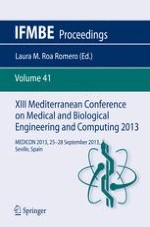2014 | OriginalPaper | Buchkapitel
Induced Transmembrane Voltage during Cell Electrofusion Using Nanosecond Electric Pulses
verfasst von : L. Rems, D. Miklavčič, G. Pucihar
Erschienen in: XIII Mediterranean Conference on Medical and Biological Engineering and Computing 2013
Aktivieren Sie unsere intelligente Suche, um passende Fachinhalte oder Patente zu finden.
Wählen Sie Textabschnitte aus um mit Künstlicher Intelligenz passenden Patente zu finden. powered by
Markieren Sie Textabschnitte, um KI-gestützt weitere passende Inhalte zu finden. powered by
Electrofusion is a method for facilitating fusion of cells in close contact by using microsecond-duration electric pulses. Electric pulses induce a voltage across cell membranes, which leads to membrane electroporation and brings the membranes into fusogenic state. However, electrofusion efficiency is very low when fusion partner cells considerably differ in size, since the magnitude of the induced transmembrane voltage (TMV) depends proportionally on the cell size when microsecond pulses are applied. Recently, we proposed that the problem of fusing differently sized cells could be overcome by simply reducing the pulse duration to nanoseconds (ns). Namely, during ns pulse exposure the TMV depends less on the cell size and more on the electric properties of the cells and the surrounding medium. To further investigate the possibility of fusing cells with ns pulses, we constructed a finite element model of equally and differently sized cells in contact, mimicking their arrangement during electrofusion. We calculated the time course of TMV for fusion media with two different conductivities (
σ
e
= 0.01 and 0.1 S/m), which are widely used in existing electrofusion protocols. Our results demonstrate that ns pulses provide the possibility to selectively electroporate the contact areas between cells (i.e. the target areas for electrofusion), regardless of the size of fusion partner cells, and for a relatively wide range of pulse durations. In medium with
σ
e
= 0.01 S/m, selective contact area electroporation can be achieved with pulses of up to few microsecond duration, whereas in medium with
σ
e
= 0.1 S/m, shorter pulses with duration below few hundred nanoseconds need to be applied. Electrofusion by means of ns pulses could, therefore, provide a method for improving fusion efficiency in cases where cells of different size need to be fused, such as in hybridoma technology for monoclonal antibody production.
